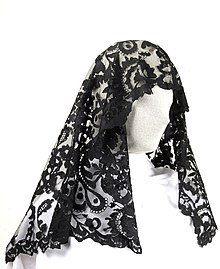mantilla

The mantilla [ man'tiʎa ] ( Spanish for “small blanket”), also sometimes referred to as a mantilla , was initially a veil worn by Spanish women from the Middle Ages , which covered the head and neck down to the shoulders. The shawl is still worn today as part of the festive costume and is largely made using cutting-edge technology. In some areas of Spain, the color of the mantilla could be used to identify the civil status of the woman who wore it: black meant that the woman was married, while white symbolized virginity .
From around the middle of the 18th century, a light women's coat, and later a back coat made of light silk that reached down to the knees, was called a mantilla. This name was adopted by fashion as a general word for a light silk fabric .
In the Catholic Church , the Codex Iuris Canonici (CIC) of 1917 stipulated that women had to wear a communion veil (mantilla or other head covering) at Holy Mass and in the presence of the Holy of Holies . By the CIC from 1983 that Canon has been completely canceled (abrogated). The 1983 CIC does not mention this question - it is no longer compulsory for women to wear a communion veil in Holy Mass. In private audiences with the Pope , wearing a mantilla is still part of the protocol. The tradition of the so-called privilège du blanc allows queens and princesses of Catholic royal families (and only them) to wear white mantillas and dresses at papal audiences and at Holy Mass for the inauguration of a Pope.
Web links
Individual evidence
- ↑ Can. 1262
